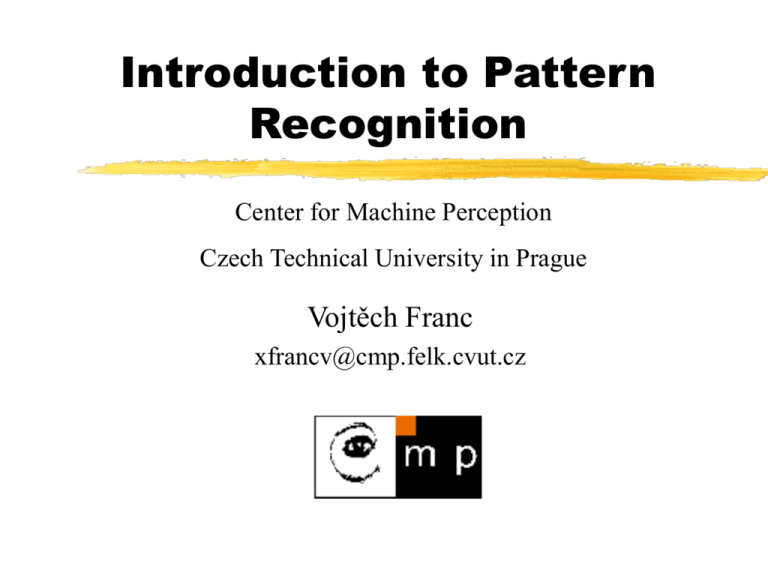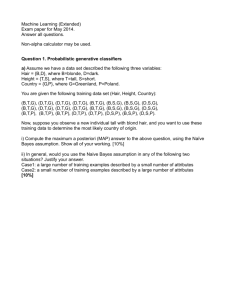Introduction to Pattern Recognition
advertisement

Introduction to Pattern
Recognition
Center for Machine Perception
Czech Technical University in Prague
Vojtěch Franc
xfrancv@cmp.felk.cvut.cz
What is pattern recognition?
“The assignment of a physical object or event to one of
several prespecified categeries” -- Duda & Hart
A pattern is an object, process or event that can be
given a name.
A pattern class (or category) is a set of patterns
sharing common attributes and usually originating from
the same source.
During recognition (or classification) given objects
are assigned to prescribed classes.
A classifier is a machine which performs classification.
Examples of applications
• Handwritten: sorting letters by postal code,
input device for PDA‘s.
• Optical Character
• Printed texts: reading machines for blind
people, digitalization of text documents.
Recognition (OCR)
• Biometrics
• Face recognition, verification, retrieval.
• Finger prints recognition.
• Speech recognition.
• Diagnostic systems
• Medical diagnosis: X-Ray, EKG analysis.
• Machine diagnostics, waster detection.
• Military applications
• Automated Target Recognition (ATR).
• Image segmentation and analysis (recognition
from aerial or satelite photographs).
Approaches
Statistical PR: based on underlying statistical model of
patterns and pattern classes.
Structural (or syntactic) PR: pattern classes
represented by means of formal structures as
grammars, automata, strings, etc.
Neural networks: classifier is represented as a
network of cells modeling neurons of the human brain
(connectionist approach).
Basic concepts
Pattern
y
x1
x
2 x
xn
Feature vector x X
- A vector of observations (measurements).
- x is a point in feature space X .
Hidden state y Y
- Cannot be directly measured.
- Patterns with equal hidden state belong to the same class.
Task
- To design a classifer (decision rule) q : X Y
which decides about a hidden state based on an onbservation.
Example
height
Task: jockey-hoopster recognition.
weight
x1
x x
2
The set of hidden state is Y {H , J }
The feature space is X 2
Training examples {( x1 , y1 ), , (xl , yl )}
Linear classifier:
yH
x2
H if (w x) b 0
q(x)
J if (w x) b 0
yJ
( w x) b 0
x1
Components of PR system
Pattern
Sensors and
preprocessing
Teacher
Feature
extraction
Classifier
Class
assignment
Learning algorithm
• Sensors and preprocessing.
• A feature extraction aims to create discriminative features good for classification.
• A classifier.
• A teacher provides information about hidden state -- supervised learning.
• A learning algorithm sets PR from training examples.
Feature extraction
Task: to extract features which are good for classification.
Good features: • Objects from the same class have similar feature values.
• Objects from different classes have different values.
“Good” features
“Bad” features
Feature extraction methods
Feature extraction
m1
m
2
mk
φ1
φ2
φn
x1
x
2
xn
Feature selection
m1
m
2
m3
mk
x1
x
2
xn
Problem can be expressed as optimization of parameters of featrure extractor φ(θ) .
Supervised methods: objective function is a criterion of separability
(discriminability) of labeled examples, e.g., linear discriminat analysis (LDA).
Unsupervised methods: lower dimesional representation which preserves important
characteristics of input data is sought for, e.g., principal component analysis (PCA).
Classifier
A classifier partitions feature space X into class-labeled regions such that
X X 1 X 2 X |Y |
X1
and
X 1 X 2 X |Y | {0}
X1
X3
X2
X1
X2
X3
The classification consists of determining to which region a feature vector x belongs to.
Borders between decision boundaries are called decision regions.
Representation of classifier
A classifier is typically represented as a set of discriminant functions
f i (x) : X , i 1,, | Y |
The classifier assigns a feature vector x to the i-the class if
f i ( x) f j ( x) j i
f1 (x)
x
Feature vector
f 2 (x)
f|Y | (x)
Discriminant function
max
y
Class identifier
Bayesian decision making
• The Bayesian decision making is a fundamental statistical approach which
allows to design the optimal classifier if complete statistical model is known.
Definition:
Obsevations X
Hidden states Y
Decisions
D
A loss function
W :Y D R
q:X D
A decision rule
A joint probability p(x, y )
Task: to design decision rule q which minimizes Bayesian risk
R(q) p(x, y ) W(q( x), y )
yY xX
Example of Bayesian task
Task: minimization of classification error.
A set of decisions D is the same as set of hidden states Y.
0 if
0/1 - loss function used W(q( x), y )
1 if
q(x) y
q(x) y
The Bayesian risk R(q) corresponds to probability of
misclassification.
The solution of Bayesian task is
p(x | y) p( y)
q arg min R(q) y arg max p( y | x) arg max
p(x)
q
y
y
*
*
Limitations of Bayesian
approach
• The statistical model p(x,y) is mostly not known therefore
learning must be employed to estimate p(x,y) from training
examples {(x1,y1),…,(x,y)} -- plug-in Bayes.
• Non-Bayesian methods offers further task formulations:
• A partial statistical model is avaliable only:
• p(y) is not known or does not exist.
• p(x|y,) is influenced by a non-random intervetion .
• The loss function is not defined.
• Examples: Neyman-Pearson‘s task, Minimax task, etc.
Discriminative approaches
Given a class of classification rules q(x;θ) parametrized by θ
the task is to find the “best” parameter θ* based on a set of
training examples {(x1,y1),…,(x,y)} -- supervised learning.
The task of learning: recognition which classification rule is
to be used.
The way how to perform the learning is determined by a
selected inductive principle.
Empirical risk minimization
principle
The true expected risk R(q) is approximated by empirical risk
1
R emp (q( x; θ)) W(q( x i ; θ), yi )
i 1
with respect to a given labeled training set {(x1,y1),…,(x,y)}.
The learning based on the empirical minimization principle is
defined as
θ* arg min R emp (q( x; θ))
θ
Examples of algorithms: Perceptron, Back-propagation, etc.
Overfitting and underfitting
Problem: how rich class of classifications q(x;θ) to use.
underfitting
good fit
overfitting
Problem of generalization: a small emprical risk Remp does not
imply small true expected risk R.
Structural risk
minimization principle
Statistical learning theory -- Vapnik & Chervonenkis.
An upper bound on the expected risk of a classification rule qQ
1
1
R(q) R emp (q) R str ( , h, log )
where is number of training examples, h is VC-dimension of class
of functions Q and 1- is confidence of the upper bound.
SRM principle: from a given nested function classes Q1,Q2,…,Qm,
such that
h1 h2 hm
select a rule q* which minimizes the upper bound on the expected risk.
Unsupervised learning
Input: training examples {x1,…,x} without information about the
hidden state.
Clustering: goal is to find clusters of data sharing similar properties.
A broad class of unsupervised learning algorithms:
{x1 ,, x }
{ y1 ,, y }
Classifier
θ
Learning
algorithm
Classifier q : X Θ Y
Learning algorithm L : (X Y) Θ
(supervised)
Example of unsupervised
learning algorithm
k-Means clustering:
{x1 ,, x }
Goal is to minimize
2
||
x
m
||
i q(xi )
i 1
Classifier
y q(x) arg min || x m i ||
i 1,, k
θ {m1 ,, m k }
m3
m1
Learning algorithm
mi
1
x j , I i { j : q(x j ) i}
| I i | jI i
{ y1 ,, y }
m2
References
Books
Duda, Heart: Pattern Classification and Scene Analysis. J. Wiley & Sons, New York,
1982. (2nd edition 2000).
Fukunaga: Introduction to Statistical Pattern Recognition. Academic Press, 1990.
Bishop: Neural Networks for Pattern Recognition. Claredon Press, Oxford, 1997.
Schlesinger, Hlaváč: Ten lectures on statistical and structural pattern recognition.
Kluwer Academic Publisher, 2002.
Journals
Journal of Pattern Recognition Society.
IEEE transactions on Neural Networks.
Pattern Recognition and Machine Learning.





